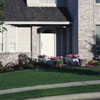Installing Concrete Flatwork
There are several different types of concrete surfaces:

Sub Floor (Living Space)
Most sub floors for living areas are made of framed wood. The sub floor is the structural floor underneath the hardwood or carpeted floors on which you walk. Concrete sub floors are usually found in basements, but they can also be patios or garage surfaces that have been enclosed and turned into living areas.
Finish Floor
Most finished floors in living areas are made of either tile, hardwood or carpet. Concrete is not a common floor finishing except in unfinished basements.
Garage or Basement
Garage or basement concrete surfaces work well in garages and basements because they are structural floorings and can take heavy use with little maintenance. Cleaning concrete is also easier than other, more-delicate flooring.
Driveway/Parking Area
Most driveway or parking areas are either concrete or asphalt. Brick or stone masonry is an expensive alternative. These areas need to handle heavy use and be easy to maintain. With concrete, you will need to finish the surface with a "brush-textured finish," a rougher surface that helps with traction.
Exterior Walkway
Concrete or stone masonry are popular options for exterior walkways. Stone masonry will be more decorative; however concrete will be less expensive and lower maintenance. A concrete walkway should also have a "brush-textured finish."
Patios
Like walkways, concrete or stone masonry are popular options for a patio. Concrete will be less expensive and quicker to custom make and should have a "brush-textured finish" like all exterior concrete surfaces.
Pad for Light Structure
Detached garages, sheds and porches need a concrete base flooring for support and structure.
Steps
Commonly found with concrete walkways, patios and porches.
Site Preparation (Excavation, Grading)
Concrete is often one of the very base foundations of any structure. Proper site preparation is necessary to insure a good foundation.
Concrete Form Work
Concrete can either be flat or shaped into three-dimensional objects. If you need steps, curbs or other form work, please discuss with your Service Professional.
Rebar Installation
Steel rebar within the concrete makes the concrete structure stronger.
Old Concrete or Paving Removed
Removing concrete or paving material is difficult work. Often it's best to leave this to your service professional, who will have proper equipment and training to handle the removal.
Finishes
Concrete surfaces come in three different finishes. The most common for interiors has a smooth finish created by running a flat trowel over the top. This can be quite smooth, almost like glass. Smooth surfaces don't work well outside; a little water can turn a smooth concrete surface into a slip hazard. Contractors will texture exterior surfaces with a "brush-textured" finish, a rougher surface that wicks away water and provides traction. Exposed aggregate finish is a rougher finish and less common. The gravel that makes up the concrete is exposed to the surface and good for traction.
Special Color or Other Additive
Concrete can come in a wide variety of colors created by adding dyes to the liquid mixture. Fixing damage to colored concrete is tricky. Getting the right blend of colors is not an exact science. Don't expect a repair person to create the perfect match. If a perfect match is critical, consider removing and replacing the area with new concrete.
Lightweight Concrete
Concrete comes in different forms with varying mixtures of cement, gravel and water. Some applications call for extremely lightweight concrete. Repairs need to have the identical lightweight mixture.
-- Tips courtesy of HomeAdvisor.com